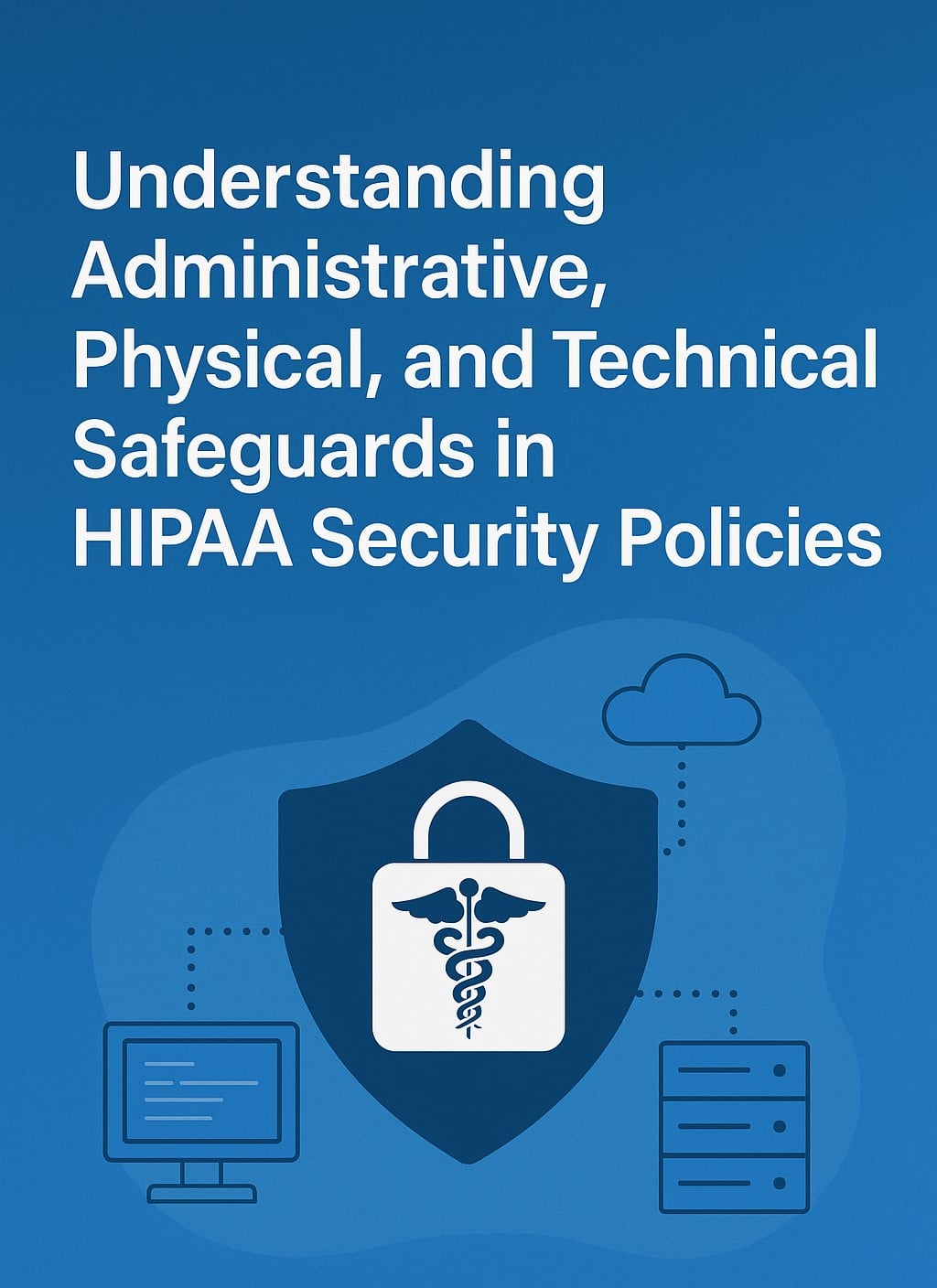Introduction
In the healthcare industry, protecting patient information is not optional—it’s a legal and ethical obligation. The Health Insurance Portability and Accountability Act (HIPAA) sets national standards to protect electronic Protected Health Information (ePHI) from unauthorized access, breaches, and misuse.
At the core of the HIPAA Security Rule are three categories of safeguards: administrative, physical, and technical. Each plays a crucial role in building a strong security framework that ensures confidentiality, integrity, and availability of ePHI. In this article, we’ll break down these safeguards, their requirements, and how healthcare organizations can implement them effectively.
1. Administrative Safeguards: The Foundation of HIPAA Compliance
Administrative safeguards form the organizational backbone of HIPAA compliance. They focus on policies, procedures, and practices that govern how ePHI is managed within an organization.
Key Components:
1.1 Security Management Process
Organizations must identify and manage risks to ePHI. This includes:
-
Conducting regular risk analyses
-
Implementing risk management strategies
-
Developing sanction policies for non-compliance
-
Maintaining information system activity reviews
1.2 Workforce Security
Ensure that only authorized personnel can access ePHI:
-
Implement authorization procedures
-
Establish supervision and training programs
-
Enforce termination policies to revoke access when necessary
1.3 Information Access Management
Access to ePHI must follow the principle of least privilege:
-
Define role-based access controls
-
Review and update access privileges regularly
1.4 Security Awareness and Training
Human error is one of the top causes of data breaches. Regular employee training helps mitigate this risk by:
-
Raising awareness about phishing and malware
-
Educating staff on password management
-
Reinforcing incident response procedures
1.5 Contingency Planning
Organizations must be prepared for emergencies:
-
Develop data backup and recovery plans
-
Create emergency operation procedures
-
Test contingency plans regularly
✅ Tip: Keep your HIPAA training up to date and document every session—it’s not just good practice; it’s a compliance requirement.
2. Physical Safeguards: Protecting the Environment Around ePHI
Physical safeguards protect the actual facilities, equipment, and devices where ePHI is stored, accessed, or transmitted. They help prevent unauthorized physical access to data systems.
Key Components:
2.1 Facility Access Controls
Limit physical entry to areas containing ePHI:
-
Implement badge access systems
-
Maintain visitor logs
-
Use surveillance systems to monitor access points
2.2 Workstation Use and Security
Workstations (desktops, laptops, tablets) should be configured to prevent unauthorized access:
-
Define usage policies
-
Position screens away from public view
-
Automatically lock systems after inactivity
2.3 Device and Media Controls
Electronic devices and media that contain ePHI must be handled securely:
-
Implement media re-use and disposal procedures
-
Use data encryption and wiping tools for old drives
-
Track and document device movement
✅ Tip: Always maintain an inventory of devices that store or transmit ePHI. Lost or untracked devices are a major source of HIPAA violations.
3. Technical Safeguards: Securing ePHI Through Technology
Technical safeguards involve technological solutions that protect ePHI from unauthorized access and cyber threats. These are critical in today’s digital healthcare environment.
Key Components:
3.1 Access Control
Control who can access ePHI and what they can do:
-
Implement unique user IDs and strong passwords
-
Use multi-factor authentication (MFA)
-
Set up automatic logoff after inactivity
3.2 Audit Controls
Track and log system activities involving ePHI:
-
Maintain audit trails for all access and modifications
-
Use intrusion detection systems
-
Review logs regularly for suspicious activities
3.3 Integrity Controls
Ensure that ePHI is not altered or destroyed without authorization:
-
Implement encryption for data storage and transmission
-
Use checksum or hashing mechanisms to detect changes
3.4 Transmission Security
Protect ePHI during electronic transmission:
-
Use secure email protocols (TLS, SSL)
-
Implement VPNs for remote access
-
Prohibit sending ePHI over unsecured channels
✅ Tip: Always encrypt ePHI at rest and in transit—this is one of the strongest safeguards against data breaches.
4. Implementing HIPAA Safeguards Effectively
Implementing these safeguards isn’t a one-time task—it’s an ongoing process of assessment, improvement, and documentation. Here are best practices to strengthen compliance:
-
Conduct regular HIPAA risk assessments
-
Update security policies as technology and threats evolve
-
Provide annual HIPAA Security Rule training for all employees
-
Test backup and recovery systems regularly
-
Document every step—if it’s not documented, it didn’t happen in the eyes of auditors
5. The Bottom Line: A Unified Approach to HIPAA Security
The three HIPAA safeguard categories—administrative, physical, and technical—work together to create a comprehensive security framework. Administrative safeguards set the rules, physical safeguards protect the environment, and technical safeguards secure the technology.
Healthcare organizations that follow these principles can:
-
Avoid costly HIPAA violations
-
Maintain patient trust
-
Protect sensitive information from growing cyber threats
Final Thoughts
Compliance with HIPAA’s Security Rule is not just about avoiding penalties—it’s about protecting lives, privacy, and the integrity of healthcare systems. By implementing strong administrative, physical, and technical safeguards, organizations can ensure that patient data remains secure in every form.
